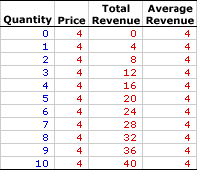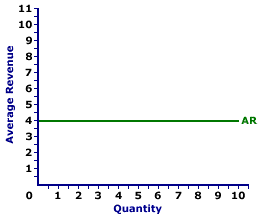
|
|
DEBTOR NATION: A nation that owes more to foreign governments, businesses, and consumers than foreigners owe to domestic governments, businesses, and consumers. The United States, having been a creditor nation for many decades, has now achieved the status of debtor nation. This sort of thing happens when exports are less than imports, creating a deficit in the current account of the balance of payments and thus a surplus in the capital account.
Visit the GLOSS*arama
|
|


|

|
                           AVERAGE REVENUE, PERFECT COMPETITION: The revenue received for selling a good per unit of output sold, found by dividing total revenue by the quantity of output. Average revenue often goes by a simpler and more widely used term... price. For a perfectly competitive firm average revenue is also equal to marginal revenue. Average revenue for a perfectly competitive firm is often depicted by a horizontal average revenue curve. Average revenue is the revenue generated per unit of output sold. It plays a role in the determination of a perfectly competitive firm's profit. Per unit profit is average revenue minus average (total) cost. A perfectly competitive firm generally seeks to produce the quantity of output that maximizes profit.The relation between average revenue and quantity of output produced depends on market structure. For a perfectly competitive firm, average revenue is not only equal to price, but more importantly, it is equal to marginal revenue, all of which are constant. For a monopoly, monopolistically competitive, or oligopoly firm, average revenue is greater than marginal revenue, both of which decrease with larger quantities of output. The constant or decreasing nature of average revenue is a prime indication of the market control of a firm. Average revenue can be represented in a table or as a curve. For a perfectly competitive firm, the average revenue curve is a horizontal, or perfectly elastic, line. The average revenue curve is also the demand curve facing the firm. The average revenue received by a firm is total revenue divided by quantity, often expressed as this simple equation: | average revenue | = | total revenue
quantity |
At times, it can be helpful to turn this equation around and calculate total revenue from average revenue: | total revenue | = | average revenue | x | quantity |
Perfect competition is a market structure with a large number of small firms, each selling identical goods. Perfectly competitive firms have perfect knowledge and perfect mobility into and out of the market. These conditions mean perfectly competitive firms are price takers, they have no market control and receive the going market price for all output sold.Average Revenue,
Zucchini Style |  |
The table to the right summarizes the average revenue received by a hypothetical firm, Phil the zucchini grower, for selling zucchinis in a perfectly competitive zucchini market. The first column is the quantity of zucchinis sold, ranging from 0 to 10 pounds. The second column is then the price Phil receives for selling his zucchinis, which is $4 per pound. The third column is the total revenue Phil receives for producing and selling alternative quantities of zucchinis. Average revenue in the forth column is found by dividing total revenue in the third column by quantity in the first column. For example, because the total revenue generated from the production of 5 pounds of zucchinis is $20, average revenue is $4 (= $20/5). Each value in the fourth column is calculated in the same way. The obvious point is that average revenue is equal to $4 for each and every pound of zucchinis sold. The reason is that price is constant at $4 for each and every pound of zucchinis sold. Average revenue is price. Price is average revenue. The two are one and the same. Average Revenue Curve,
Zucchini Style |  |
Average revenue is commonly represented by an average revenue curve, such as the one displayed in the exhibit to the right. This particular average revenue curve is that for zucchini sales by Phil the zucchini grower, a presumed perfectly competitive firm. The vertical axis measures average revenue and the horizontal axis measures the quantity of output (pounds of zucchinis). Although quantity on this particular graph stops at 10 pounds of zucchinis, the nature of perfect competition indicates it could easily go higher. This curve indicates that if Phil sells 1 pound of zucchinis, then his revenue per unit is $4. However, if he sells 10 pounds, then he also receives $4 of average revenue. Should he sell 100 pounds, then he moves well beyond the graph, but his average revenue remains at $4. The average revenue curve is actually the demand curve for Phil's zucchinis. In fact, in the same way that average revenue is just another term for price, the average revenue curve is just another term for demand curve.

Recommended Citation:AVERAGE REVENUE, PERFECT COMPETITION, AmosWEB Encyclonomic WEB*pedia, http://www.AmosWEB.com, AmosWEB LLC, 2000-2025. [Accessed: July 18, 2025].
Check Out These Related Terms... | | | | | | | | |
Or For A Little Background... | | | | | | | | | | |
And For Further Study... | | | | | | | | |
Related Websites (Will Open in New Window)... | | | |
Search Again?
Back to the WEB*pedia
|



|

|
BLACK DISMALAPOD
[What's This?]
Today, you are likely to spend a great deal of time browsing about a thrift store seeking to buy either a genuine fake plastic Tiffany lamp or a microwave over that won't burn your popcorn. Be on the lookout for small children selling products door-to-door.
Your Complete Scope
This isn't me! What am I?
|

|
|
Three-forths of the gold mined each year is used to manufacture jewelry.
|

|
|
"A winner is someone who recognizes his God-given talents, works his tail off to develop them into skills, and uses those skills to accomplish his goals. " -- Larry Bird, basketball player
|

|
EER
European Economic Review
|

|
|
Tell us what you think about AmosWEB. Like what you see? Have suggestions for improvements? Let us know. Click the User Feedback link.
User Feedback
|


|


